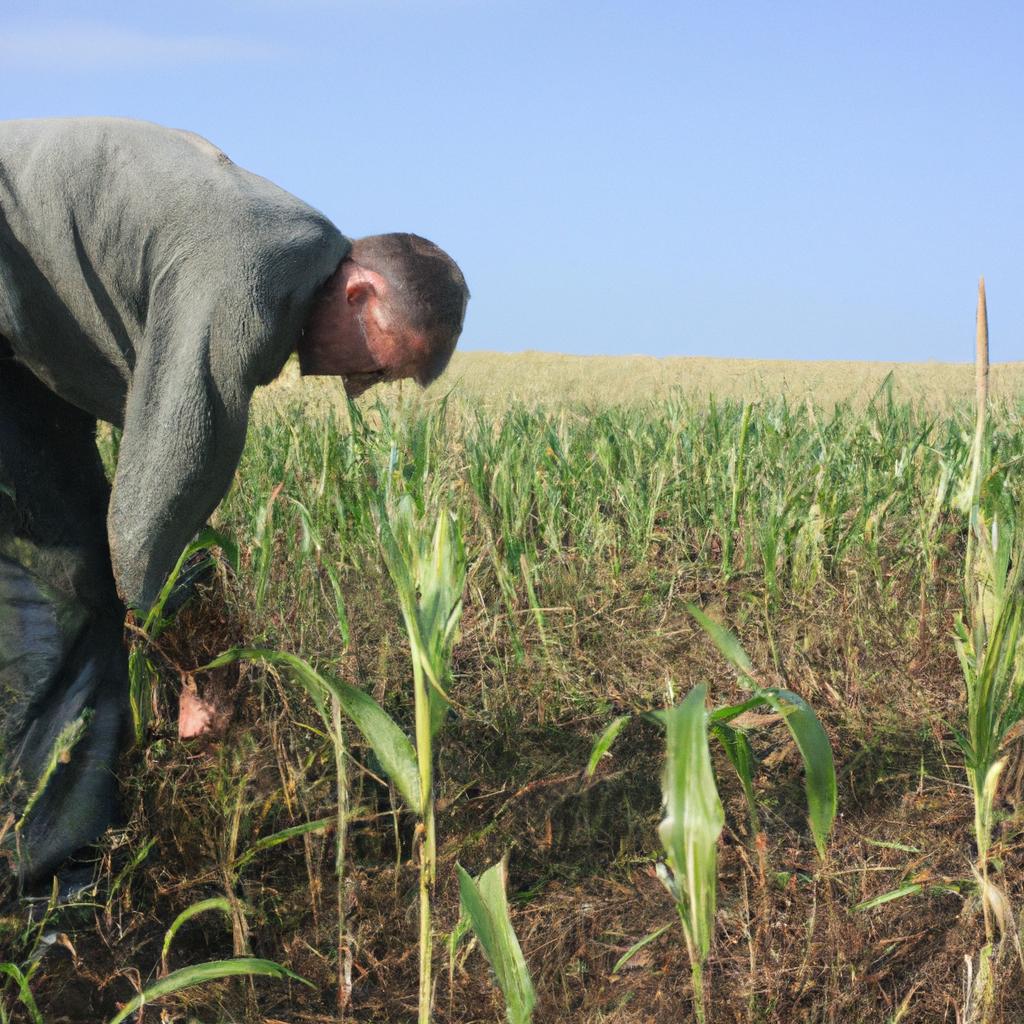Agricultural insurance plays a crucial role in mitigating the financial risks faced by businesses operating in the agriculture and forestry sectors. With its ability to provide protection against unpredictable natural events such as droughts, floods, or pest infestations, it offers valuable support for farmers and forest owners alike. For instance, consider a hypothetical case study of a maize farmer who has invested significant capital into cultivating his crop. Despite implementing all necessary precautions, an unforeseen hailstorm destroys a substantial portion of his harvest. In this scenario, agricultural insurance could serve as a lifeline by compensating the farmer for his losses and helping him recover financially.
In addition to safeguarding individual enterprises from potential disasters, agricultural insurance also contributes to the overall stability and sustainability of the industry at large. By providing coverage for various types of risks including yield fluctuations, market price volatility, disease outbreaks, or even equipment breakdowns, it helps create a more secure environment for business operations within the sector. Furthermore, agricultural insurance allows farmers and forest owners to make informed decisions regarding investments in new technologies or expansion plans without fear of losing everything due to uncontrollable circumstances. As such, understanding the intricacies of agri-finance and how agricultural insurance fits into this framework is essential for any business involved in the agriculture or forestry sectors.
Agricultural insurance is a key component of agri-finance, which encompasses all financial aspects related to agricultural activities. It provides a safety net for farmers and forest owners by protecting their investments and ensuring they can recover from unexpected losses. By transferring the risk of potential disasters to insurance companies, agricultural insurance allows businesses to focus on their core operations without constantly worrying about the impact of uncontrollable events.
Moreover, agricultural insurance promotes sustainability within the industry. It encourages responsible risk management practices by incentivizing farmers and forest owners to adopt measures that reduce vulnerability to natural hazards. For example, insurance premiums may be lower for those who implement irrigation systems or pest control strategies. This not only protects individual businesses but also contributes to the overall resilience of the sector in the face of climate change and other challenges.
Furthermore, agricultural insurance plays a role in facilitating access to finance for farmers and forest owners. Lenders are more willing to provide loans when there is assurance that potential losses will be covered by insurance. This enables businesses to secure funding for investments in modern machinery, improved infrastructure, or sustainable farming practices.
Overall, understanding how agricultural insurance fits into the broader context of agri-finance is crucial for businesses in the agriculture and forestry sectors. It helps them manage risks effectively, maintain financial stability, promote sustainability, and access necessary funding for growth and innovation.
Understanding the Importance of Agricultural Insurance
In today’s dynamic agricultural landscape, farmers and agribusinesses face a range of risks that can greatly impact their operations and financial stability. One such risk is the occurrence of natural disasters, which can result in crop failure, livestock losses, or damage to farm infrastructure. For instance, consider a hypothetical scenario where a severe drought devastates an entire region’s crops, leading to substantial financial losses for farmers who were unprepared.
To mitigate these risks and safeguard against potential losses, agricultural insurance plays a critical role in supporting business agriculture and forestry. By providing coverage against various perils, including weather-related events, disease outbreaks, and market fluctuations, agricultural insurance offers protection when unforeseen circumstances arise. This support enables farmers to recover from setbacks more quickly and continue operating with reduced financial strain.
The importance of agricultural insurance becomes evident when considering its benefits:
- Risk management: Agricultural insurance allows farmers to transfer some of the risks associated with farming activities to insurers. By doing so, they gain peace of mind knowing that their investments are protected even in challenging times.
- Financial stability: In cases where significant loss occurs due to unexpected events like floods or wildfires, having adequate insurance coverage can help farmers maintain financial stability by compensating for lost income and enabling them to cover necessary expenses.
- Access to credit: Lenders often require borrowers involved in agriculture or forestry businesses to have insurance coverage as it reduces their risk exposure. Having reliable insurance increases access to credit options and helps secure favorable loan terms.
- Sustainability: The availability of robust agricultural insurance systems encourages innovation and sustainability within the industry. Farmers feel more confident taking calculated risks with new technologies or practices since they know they have a safety net if things don’t go as planned.
To further illustrate the significance of agricultural insurance in protecting livelihoods and fostering economic growth within rural communities, consider the following table:
| Benefits | Description | Example |
|---|---|---|
| Risk diversification | Spreads the potential financial burden of losses across a larger pool | Crop insurance programs provided by government bodies |
| Resilience | Helps farmers recover and rebuild their operations after unexpected events | Livestock mortality coverage for disease outbreaks |
| Market stability | Minimizes price volatility, ensuring stable incomes for producers | Price risk protection through commodity futures |
| Disaster recovery | Assists in rebuilding damaged infrastructure and restoring farming activities | Coverage for repairs needed after a hurricane |
In summary, agricultural insurance serves as an essential tool in safeguarding business agriculture and forestry. By managing risks, providing financial stability, promoting sustainability, and facilitating access to credit, it plays a crucial role in supporting rural economies. In the upcoming section on “Types of Agricultural Insurance Coverage,” we will explore the various forms of insurance available to farmers and agribusinesses to better understand how they can tailor their coverage to specific needs.
Next, let us delve into the different types of agricultural insurance coverage without delay.
Types of Agricultural Insurance Coverage
Building upon our previous exploration of agricultural insurance, let us now delve deeper into the various types of coverage available in this crucial aspect of agri-finance. To better illustrate its significance, consider a hypothetical scenario where a farmer named John experiences extensive crop damage due to severe weather conditions. Despite his best efforts and investments, his entire harvest is lost, leading to significant financial losses that jeopardize not only his livelihood but also the stability of his farming operation.
Types of Agricultural Insurance Coverage
-
Crop Insurance:
- Provides protection against yield or revenue loss caused by natural disasters such as droughts, floods, hailstorms, etc.
- Covers both traditional crops like corn, wheat, soybeans as well as specialty crops such as fruits and vegetables.
- Offers different coverage levels based on factors like historical yields and market prices.
- Enables farmers to manage risk more effectively by compensating for potential losses.
-
Livestock Insurance:
- Safeguards livestock owners against perils that can lead to death or disease outbreaks among their animals.
- Protects farmers from sudden declines in animal value due to events like accidents, diseases, or adverse weather conditions.
- Assists in covering veterinary expenses incurred during treatment and helps replenish herd sizes if necessary.
-
Property and Equipment Insurance:
- Guards agricultural businesses against damages or losses to buildings, machinery, equipment, and other physical assets.
- Covers risks arising from fire incidents, thefts, vandalism or any unforeseen circumstances affecting farm infrastructure.
- Eases financial burden by providing compensation for repairs/replacements required to resume normal operations promptly.
- Peace of mind knowing that unexpected events won’t completely devastate one’s farming enterprise.
- Enhanced ability to secure loans and attract investment with proper insurance coverage in place.
- Protection against uncertainties allows farmers to focus on sustainable agricultural practices.
- Mitigation of financial risk provides stability for both farm families and rural economies.
Emotional Table:
| Types of Coverage | Benefits |
|---|---|
| Crop Insurance | Compensation for crop losses due to natural disasters. |
| Livestock Insurance | Protection against loss or illness in livestock, ensuring herd stability. |
| Property and Equipment Insurance | Coverage for damages or losses to buildings, machinery, and physical assets. |
As we have seen, agricultural insurance encompasses a wide range of coverage options that prove essential in safeguarding the interests of farmers like John. With this understanding established, let us now turn our attention to the key factors one should consider when choosing an agricultural insurance provider, ensuring maximum protection and support in times of need.
Factors to Consider When Choosing an Agricultural Insurance Provider
Types of Agricultural Insurance Coverage play a crucial role in mitigating risks and safeguarding the financial stability of businesses in agriculture and forestry. As we delve deeper into this topic, it is important to understand the factors that should be considered when selecting an agricultural insurance provider.
One example illustrating the significance of choosing the right insurance coverage involves a hypothetical scenario where a crop farmer experiences a severe drought during the planting season. Without adequate insurance coverage, the farmer may face significant losses due to reduced yield or complete crop failure. However, with proper coverage such as weather-based index insurance, which compensates farmers based on predetermined climate conditions, they can receive compensation for their losses and sustain their operations.
When contemplating agricultural insurance providers, there are several critical factors to consider:
- Reputation: Assessing an insurer’s reputation within the industry helps determine their reliability and ability to fulfill claims promptly.
- Coverage Options: It is essential to evaluate whether an insurer offers comprehensive coverage options tailored specifically to your business needs. This includes considering specific risks faced by your agricultural operation.
- Financial Stability: Examining an insurer’s financial strength rating provides insight into their ability to meet claim obligations even during challenging economic times.
- Customer Support: Good customer support ensures prompt assistance during policy selection, claims processing, and other inquiries related to your insurance coverage.
To further illustrate these considerations visually, below is a table showcasing four leading agricultural insurers along with key attributes:
| Insurer | Reputation | Coverage Options | Financial Stability |
|---|---|---|---|
| ABC Insurance | Excellent | Livestock, Crop, Property | A++ |
| XYZ Assurance | Good | Crop, Liability | A+ |
| FarmGuard Underwriters | Fair | Livestock | B |
| AgriRisk Solutions | Poor | Crop | C |
This table presents a snapshot of four insurers based on their reputation, coverage options, and financial stability. It is crucial to balance these factors when selecting an agricultural insurance provider that aligns with your specific needs.
In conclusion, choosing the right agricultural insurance coverage requires thoughtful consideration of various factors such as reputation, coverage options, financial stability, and customer support. By carefully evaluating these aspects and referencing case studies like the hypothetical drought scenario mentioned earlier, businesses in agriculture and forestry can make informed decisions when it comes to managing risks through proper insurance coverage.
Moving forward, let us now explore The Role of Agricultural Insurance in Risk Management and its broader implications for businesses in this sector.
The Role of Agricultural Insurance in Risk Management
Having explored the importance of agricultural insurance in the previous section, it is now crucial to understand the factors that should be considered when selecting an appropriate insurance provider. To illustrate this point, let us consider a hypothetical case study involving a farmer named John.
First and foremost, John needs to evaluate the financial stability and reputation of potential insurance providers. By examining their financial statements and credit ratings, he can ensure that they have the necessary resources to provide coverage when needed. Additionally, checking customer reviews and seeking recommendations from other farmers will help him gauge the reliability and quality of service offered by each provider.
Secondly, John must carefully assess the range of coverage options available. Different types of agriculture entail unique risks, so it is essential for him to choose an insurance policy tailored specifically to his farming operations. For instance, if John primarily grows crops susceptible to weather-related damage such as hail or droughts, he would need an insurance plan that provides adequate protection against these perils.
Furthermore, pricing plays a significant role in choosing an agricultural insurance provider. While cost should not be the sole determinant factor, it is important for John to compare premiums from different insurers. Here are some key considerations related to pricing:
- The deductibles associated with various policies
- Any discounts or incentives provided by specific insurers
- The payment schedule and flexibility offered by each provider
- Whether any government subsidies or support programs are available
To summarize these points visually:
| Factors | Considerations |
|---|---|
| Financial Stability | – Examine financial statements- Check credit ratings |
| Coverage Options | – Assess suitability for specific farming operations |
| Pricing | – Compare premiums- Evaluate deductibles- Look for discounts/incentives- Consider payment schedule & flexibility |
In conclusion (without using those exact words), mindful consideration of these factors will enable farmers like John to make informed decisions when selecting an agricultural insurance provider. The next section will explore how agricultural insurance supports business sustainability, further emphasizing the importance of this financial tool in mitigating risks and ensuring long-term success.
How Agricultural Insurance Supports Business Sustainability
As illustrated by a hypothetical case study, agricultural insurance plays a crucial role in mitigating risks faced by businesses in the agriculture and forestry sector. Suppose there is a family-owned apple orchard that has been hit by an unexpected hailstorm, resulting in significant damage to their crops. Without adequate insurance coverage, this unfortunate event could lead to substantial financial losses for the orchard owners. However, with agricultural insurance in place, they are able to recover from such unforeseen circumstances and continue operating their business effectively.
Agricultural insurance offers various benefits that contribute to risk management within the industry. Firstly, it provides protection against natural disasters such as floods, droughts, storms, pests, and diseases. By safeguarding farmers and foresters against these unpredictable events, agricultural insurance acts as a safety net that ensures their livelihoods remain secure even in times of crisis.
Furthermore, agricultural insurance encourages investment and growth within the sector. With the knowledge that they have comprehensive coverage for potential crop failures or livestock losses, farmers and foresters are more willing to take calculated risks and make long-term investments in modernizing their operations or expanding their businesses. This increased confidence contributes to the overall sustainability of agricultural enterprises.
- Peace of mind: Knowing that your hard work will not go to waste due to unforeseen circumstances.
- Stability: Ensuring stable income and protecting against financial hardships caused by adverse events.
- Continuity: Safeguarding generational legacies by providing security for future generations.
- Community support: Strengthening rural communities through resilience-building measures.
In addition to these benefits, here is an example table showcasing how different types of agricultural insurance can address specific risks:
| Type of Insurance | Risk Covered | Benefit |
|---|---|---|
| Crop Insurance | Crop failures | Financial protection for farmers against yield losses |
| Livestock Insurance | Livestock mortality | Compensation for the loss of livestock due to disease or accidents |
| Property Insurance | Damage to farm structures | Coverage for repair or replacement costs |
| Liability Insurance | Accidents on the premises | Protection against legal claims resulting from injuries |
In conclusion, agricultural insurance is a vital tool in risk management within the business agriculture and forestry sectors. By providing protection against natural disasters and encouraging investment, it ensures stability, continuity, and community support. The next section will delve into tips for making a claim on agricultural insurance, highlighting the necessary steps that businesses should follow to ensure a smooth process.
Tips for Making a Claim on Agricultural Insurance
Section Title: The Importance of Risk Assessment in Agricultural Insurance
Building upon the discussion on how agricultural insurance supports business sustainability, it is crucial to emphasize the significance of conducting thorough risk assessments when considering agricultural insurance options. By assessing potential risks and vulnerabilities, farmers and agribusiness owners can make informed decisions that will help protect their investments and ensure long-term viability.
Paragraph 1:
To illustrate the importance of risk assessment, let us consider a hypothetical case study of a dairy farm facing various challenges. This farm relies heavily on its herd for milk production, which constitutes a significant portion of its revenue stream. In this scenario, understanding and mitigating risks associated with livestock health issues, extreme weather events, market fluctuations, and feed availability are vital factors that contribute to sustaining the overall productivity and profitability of the operation.
Risk assessment plays a pivotal role in agricultural insurance by:
- Identifying specific threats or hazards within an agricultural setting
- Evaluating the likelihood and potential impact of each identified risk
- Prioritizing risks based on severity and financial implications
- Developing appropriate strategies to minimize or transfer these risks
| Risks Identified | Likelihood (%) | Potential Impact ($) |
|---|---|---|
| Livestock diseases | 20 | $50,000 |
| Drought | 10 | $100,000 |
| Price volatility | 30 | $70,000 |
| Feed scarcity | 15 | $60,000 |
Paragraph 2:
The table above highlights some common risks faced by agricultural businesses such as livestock diseases, droughts, price volatility in markets, and feed scarcity. Each risk has been assigned a likelihood percentage reflecting the probability of occurrence along with an estimated potential financial impact. Through diligent risk assessment, farmers can allocate resources effectively and select insurance coverage that adequately addresses the identified risks. This approach provides a foundation for developing a robust risk management plan tailored to individual farm operations.
Paragraph 3:
By integrating risk assessment practices into agricultural insurance decision-making processes, farmers and agribusiness owners can proactively safeguard their enterprises against potential losses. Identifying vulnerabilities enables them to make informed choices regarding the types of policies required and the level of coverage necessary. Moreover, this proactive approach fosters resilience in the face of unforeseen circumstances, contributing to long-term business sustainability.
Incorporating risk assessment as an integral part of agricultural insurance strategies is crucial for ensuring optimal protection and mitigating financial uncertainties in the farming industry. By recognizing specific risks, evaluating their likelihoods and potential impacts, prioritizing actions, and aligning insurance coverage accordingly, agricultural businesses can enhance their ability to withstand challenges and secure long-term success.




